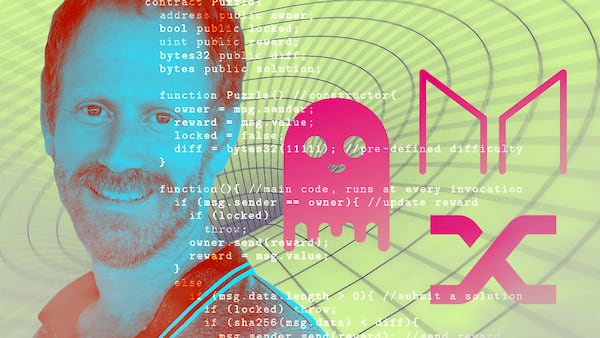- GHO, a stablecoin from DeFi lender Aave, has been trading below $1 since its summer launch.
- The initial focus was on growth, rather than maintaining the $1 peg, according to Aave's founder.
- A committee has been charged with raising GHO to $1, and its temporary leader has given himself a goal: $0.985 by November 30.
His unofficial title evoked cult-of-personality dictators or the kind of sweeping powers a head of state only wields during times of war.
But when pseudonymous DeFi developer TokenBrice cheekily announced he was chosen “temporary and benevolent leader” of an effort to raise Aave’s GHO stablecoin to its $1 peg, he hinted at the scale of the challenge, the many resources that would be marshalled in the weeks to come.
“The phase of low-scale experimenting with $GHO is over; it’s time to raise the stakes!” He wrote on X, formerly Twitter, in a post detailing the multi-pronged effort.
The goal is to bring GHO to $0.985 by November 30. It has been trading below its $1 peg since launch and trending downward. On November 18, it was worth a little more than $0.96.
GHO is minted when Aave users borrow it against crypto collateral worth more than the GHO being borrowed. As of Tuesday, there were more than 32 million GHO tokens in circulation.
Issues
“In simplicity the Aave DAO chose growth as a [go-to-market strategy],” Aave founder Stani Kulechov told DL News, referring to the digital cooperative tasked with governing Aave and GHO. “Now the focus has shifted towards a peg.”
But there’s a chicken-and-egg situation at play, according to Rune Christensen, the founder of the $5 billion DAI stablecoin.
“The number one task for crypto stablecoins is catering to the demand side” — getting people to hold the tokens for savings or payment, Christensen said. “The problem is when the peg is not prioritized it becomes a vicious cycle, because a failed peg is the biggest issue in attracting more demand.”
A month after GHO’s July launch, stablecoin researchers said the discount was due to insufficient demand for GHO and lack of a proper redemption mechanism by which holders can swap the token for $1 in crypto assets.
That redemption mechanism keeps other stablecoins near their peg by creating an arbitrage opportunity for traders. If the token is trading below $1, for example, they can buy it on secondary markets and redeem it, pocketing the difference. That “buy” pressure lifts the token’s price and eventually nudges it back towards its peg.
The relatively low cost of borrowing GHO has also pushed the token below its $1 peg, according to TokenBrice and others. Before Wednesday, the interest rate on GHO was 3%, making it cheaper to borrow GHO than to borrow other stablecoins, such as Maker’s DAI.
TokenBrice also blamed GHO’s de-peg on a lack of “utility.” Unlike other stablecoins, GHO provides its holders few opportunities to make money from the token.
“Thus, most borrowers who enjoy lower-than-market borrowing costs are happily selling their GHO for another stablecoin to earn yield with these, such as $DAI,” he wrote.
TokenBrice did not respond to requests for comment.
Solutions
On October 16, the Aave DAO approved the creation of a “liquidity committee” tasked with bringing GHO back to $1 and improving its liquidity. On October 30, TokenBrice said on X that he had been chosen to lead that liquidity committee.
Members of the committee contacted by DL News did not respond by time of publication.
“Tough times require tough measures. With GHO at $0.96, it was our responsibility to ensure the [liquidity committee] was maximally efficient,” he wrote. He said he plans to resign as leader if GHO has not risen to $0.985 by November 30.
On November 10, TokenBrice detailed the measures that had already been implemented. The committee is doling out incentives on three protocols — Maverick, Bunni and Uniswap — for people who provide liquidity to pools in which one can trade GHO against a trio of other stablecoins: USDC, USDT, LUSD.
And, since September, the DAO has slowly increased the cost of borrowing GHO, from 1.5% to 4.72%.
Other plans, such as using GHO as collateral to borrow other stablecoins on Aave and creating a “GHO Stability Module” to enable redemptions, are still being discussed or worked on by the DAO.
In addition to the measures above, the Aave DAO can consider buying up some of the circulating GHO, Christensen said.
“As long as these methods are done sufficiently, it is always quickly possible to restore the peg,” he said.
In his opinion, TokenBrice and the liquidity committee should make “unlimited, large scale adjustments” to raise GHO to $1, even if it means a little short-term pain — a move that will signal the DAO “will always ensure the peg is protected and restored instantly using any means necessary without compromise.”
“This would be an important driver of real demand for GHO, which in turn drives scale of the system,” he continued. “And the main benefit and upside of a stablecoin, for all types of users, comes from scale and network effects.”
In the meantime, the price of GHO has yet to budge: On November 1, it was trading around $0.965. For much of the past week, it was trading between $0.95 and $0.96, until recovering slightly over the weekend.
“Whether we can deliver on the objective or not, we will have pioneered using new & efficient liquidity management tools & learned a ton about them,” TokenBrice wrote. “This is an open-air liquidity/stablecoin laboratory, and anyone can monitor the evolution of the situation and partake by supplying the pools listed above or longing GHO.”
Aleks Gilbert is our New York-based DeFi Correspondent. Have a tip about stablecoins? Drop him a line at aleks@dlnews.com.
Update, November 20: The spelling of Stani Kulechov was corrected.







